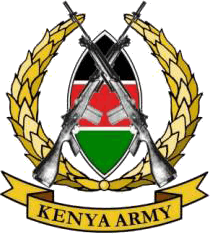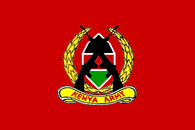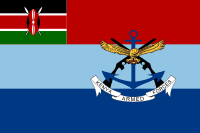Kenya Army
The Kenya Army is the land arm of the Kenya Defence Forces.
| Kenyan Army Jeshi la Ardhi la Kenya | |
|---|---|
 Coat of arms of the Kenya Army | |
| Active | 1964–present |
| Country | |
| Type | Army |
| Part of | |
| Command Headquarters | Nairobi, Kenya |
| Equipment | 186 main battle tanks (primarily Vickers), a few thousand military vehicles, 78 helicopters |
| Engagements | Second World War (as King's African Rifles) Shifta War (1963–67) Mount Elgon insurgency (2005-08) Operation Linda Nchi (2011–12) and African Union Mission in Somalia (2012–present) |
| Commanders | |
| Commander-in-Chief | President Uhuru Kenyatta |
| Commander Kenya Army | Lieutenant General Walter Koipaton Raria |
| Insignia | |
| Flag |  |
History
The origin of the present day Kenya Army lie with the British Army's King's African Rifles.[1] The reasons that necessitated the recruitment and formation of troops that preceded the King's African Rifles and in essence the Kenya Army are as many as they are varied. Tracing the events that were unfolding in East Africa during the last quarter of the 19th Century is thus important. This period was characterised by active involvement of the British in the enforcement of abolition of slave trade in East Africa.
During the same period other European nations were also developing spheres of influence in Africa. In this rivalry the British established the Imperial British East Africa Company to take care of its interests. As these interests developed and expanded, there was need to create a more formidable force to safeguard these interests and expansion. It is out of this that the first indigenous land forces in Kenya can be traced.
In 1873 the Sultan of Zanzibar, Seyyid Barghash, signed the final treaty to abolish slave trade in all his dominions. The task of enforcing the abolition was vested with Royal Navy forces under Admiral Freeman Tie.
In 1877 a Royal Navy Officer, Lt Lloyd Matthews, serving on HMS London formed a small force of 300 Zanzibaris for the purpose of combating the slave trade. During the following year Lt Matthews was given leave to serve under the Sultan who appointed him Brigadier General in command of the newly established force. By 1880 the force had grown to 1300 men who were all armed with Snider rifles donated to the Sultan by the British Government.
On 8 September 1888 the British Africa Company was granted a royal charter and was charged with the responsibility of administering British East Africa on the lines of a Crown colony. In 1893 the three-year contract with the Indian contingent came to an end. During the same period the company was experiencing serious financial problems that had led to the abandonment of Uganda and Jubaland in fact, the company could barely police the coast. Then British Consul in Zanzibar at the time, Sir Arthur Hardinge notified the foreign office of his intention of taking over East Africa from the company. The British government accepted. On 1 July 1895 a British protectorate was declared over all the areas previously administered by the company. The company troops were subsequently reorganized under Capt Hatch.
In August 1895 the British government sanctioned the establishment of a force composed of 300 Punjabi, 300 Swahili, 100 Sudanese, and 200 soldiers from various ethnic groups in the region. This force was renamed the East African Rifles and was formed from the former IBEA force in Mombasa (Fort Jesus). As the King's African Rifles, the force fought against the Mau Mau rebels under the command of British officers and on the side of loyalist Kenyans and those who advocated a peaceful transition to independence, such as Jomo Kenyatta.
Peacekeeping missions and other conflicts
In addition to the primary role of the defense of the Republic of Kenya and the secondary role of aid to civil authority, the Kenya Army has participated and continues to participate in international Peace Support Operations. Peace Support Operations within the Kenya Army can be traced back to 1973 when the United Nations requested Kenya to contribute forces to UNEF II which was to separate Israel and the Arab states after the October War. Though Kenya acceded to the UN request, the troops were not deployed due to various logistical constraints.
The first participation of the Kenya Army in Peace Support Operations was in 1979, when the Commonwealth requested the Republic of Kenya to contribute troops for the Commonwealth Monitoring Force in Rhodesia (now Zimbabwe). The country was emerging from a liberation war waged against the regime of Ian Smith which had unilaterally declared independence from the British.
Subsequently, the Kenya Army contributed officers towards peace support operations in Chad in 1982 on the request of the Organization of African Unity. Kenya has consistently participated in the United Nations Peace-Keeping operations since 1989 when she sent military observers and an infantry battalion to Namibia. Kenya has ranked number 6 out of the 90 countries who contribute military and civilian police to the UN operations.
Since 1989,[1] Kenya has contributed military observers, staff officers, civilian police monitors, and infantry troops to various missions.[2] The level of participation has also included force commanders, chief military observers, and chiefs of staff to the following UN and African Union missions:
- United Nations Observer Mission in Liberia (Liberia) – Chief Military Observer
- United Nations Mission in Liberia - Major General Leonard Ngondi was appointed Force Commander in December 2012.[3]
- ONUMOZ in Mozambique – Chief Military Observer
- United Nations Transitional Assistance Group in Namibia – then-Brigadier General Daniel Opande was appointed Deputy Force Commander
- United Nations Protection Force (UNPROFOR) in the Federal Republic of Yugoslavia – Chief Military Observer
- UNMOP (Croatia) – Chief Military Observer
- AMISOM (Somalia)
To date, Kenyan United Nations peacekeepers have served in 16 different countries in Africa, the Middle East, the Balkans, and Asia. The period of deployment of the personnel has varied from mission to mission, in accordance with the complexities of each conflict situation. Missions have ranged from one to eight years.
Structure
The Kenya Army is made up of various formations and services.
Kenya Army Formations
- 2 Brigade
- 3rd Kenya Rifles. This is Kenya's oldest unit which dates back to the 1880s. They are based in Lanet, Nakuru. Their Colour is red and their motto is 'Red Scarlets'
- 5th Kenya Rifles. Based in Gilgil, their colour is Dark Blue. Their unit motto is 'Fighting Five'
- 9 Kenya Rifles - Moi Barracks, Eldoret. Their colour is Orange. Their unit motto is 'Orangers fire and war machines'.
- 21 Transport Company
- 22 Field Workshop
- 23 Ordnance Company
- 4 Brigade
- 1st Kenya Rifles. Based in Nanyuki, Their motto is 'Green Fire' and their colour is Green.
- 7 Kenya Rifles - Langata Barracks, Nairobi. Their colour is Maroon and their unit motto is 'Maroon Commandoes' and 'Man to man I am the best'
- 15 Kenya Rifles. Formed in the early 1990s. It has been based in the coastal region of the country. currently housed at Mariakani Barracks. Their colour is Blue and the unit motto is 'Stay High'.
- 41 Transport Company
- 42 Field Workshop
- 43 Ordnance Company
- 6 Brigade - formed by 2010[4][5] - relocated from Embakasi to Modika Barracks, Garissa.[6]
- 17 Kenya Rifles - Formed in 2011 and in late 2018 stationed at Modika.[6] They are known as the 'Desert Rangers' and their colour is purple. They initially used desert brown as their colour, which was changed to new, purple colours during the 2018 Jamhuri Day ceremonies.
- 19 Kenya Rifles - Nyali Barracks.[6] Also known as the 'Ash Warriors'. Their unit colour is Ash Grey.
- 21 Kenya Rifles - Mariakani Barracks.[6]
- 61 Transport Company
- 62 Field Workshop
- 63 Ordnance Company
- 8 Brigade
- 23 MIB (Mechanised Infantry Battalion)
- 25 MIB (Mechanised Infantry Battalion)
- 27 MIB (Mechanised Infantry Battalion)
- 110 Brigade
- 112 Brigade
- Ranger Regiment
- 20 Parachute Battalion
- 30 Battalion
- 40 Ranger Strike Force Battalion
- Special Operations Training School (SOTS)
- Kenya Army Artillery Brigade
- 66 Artillery Battalion
- 75 Artillery Battalion (AD)
- 77 Artillery Battalion
- 8 Artillery Battalion
- School of Artillery (Kenya)
- Kenya Army Armoured Brigade
- 76 Armoured Reconnaissance Battalion (ARB)
- 78 Tank Battalion
- 81 Tank Battalion
- 86 Armoured Reconnaissance Battalion (ARB)
- 91 Tank Battalion
- School Of Armour
- Kenya Army Engineers Brigade
- 10 Engineers Battalion
- 12 Engineers Battalion
- School of Combat Engineering (SOCE)
- Kenya Army Corps of Signals (KACS)
- AHQ Signal Battalion
- School of Signals
Kenya Army services
- Kenya Army Ordnance Corps
- Defence Forces Ordnance Depot (DFOD)
- 2nd Ordnance Battalion
- School of Ordnance (SOO)
- Kenya Army Corps of Transport (KACT)
- Transport Battalion
- Heavy Lift Battalion
- School of Transport (SOT)
- Kenya Army Corps of Electrical and Mechanical Engineering (KACEME)
This Corps mainly deals with maintenance of motor and mechanical equipment that is used in the Kenya Army. It is based at Kahawa Garrison along Thika Road.
- Workshop Battalion
- School of Electrical and Mechanical Engineering (SEME)
- Military Police Corps (MPC) - based at the Defence Headquarters along Lenana Road Nairobi
- 1 MP battalion
- 2 MP battalion
- School of Military Police (SOMP)
- Kenya Army Medical Corps (KAMC)
- Medical Battalion
- Kenya Army Corps of Education (KACE)
- Defence Forces Constabulary (DFC)
Notes
- "Ministry of Defence – Kenya". Retrieved 13 August 2017.
- "Peacekeeping Operations". Archived from the original on 27 September 2013. Retrieved 25 April 2013.
- Africa Research Bulletin, Vol 49, No 12, 1–31 December 2012.
- https://www.nation.co.ke/news/New-Kenya-military-bosses-appointed/1056-1060676-il8gk/index.html
- https://sonkonews.com/things-know-kenya-military-base-garissa/
- "Terror level in Northern Kenya currently very high".
Further reading
- Jonah Mwangi; Esther Wanjiku; Muthusi Kimwele, eds. (2019). The Soldier's Legacy: The Kenya Army at 55: A Steadfast Shield from 1963 into Posterity. Woodlands Road, Nairobi: Kenya Army. ISBN 978-9966-804-32-7.
- 'Operation Linda Nchi: Kenya's Military Experience in Somalia,' 2014.
.svg.png)
